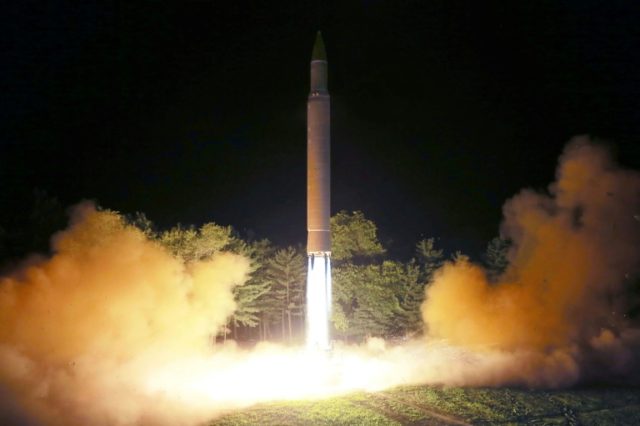Washington (AFP) – President Donald Trump issued an apocalyptic warning to North Korea on Tuesday, saying it faces “fire and fury” over its missile program, hours after US media reported Pyongyang has successfully miniaturized a nuclear warhead.
“North Korea best not make any more threats to the United States,” said Trump, who was speaking from his golf club in New Jersey. “They will be met with fire and fury like the world has never seen.”
Trump’s warning followed a Washington Post report that quoted a Defense Intelligence Agency analysis as saying officials think North Korea now has “nuclear weapons for ballistic missile delivery” — including in its intercontinental ballistic missiles.
The Pentagon did not comment on the story, but the Post said two US officials familiar with the analysis had verified the assessment’s broad conclusions, and CNN said it had confirmed the report.
The progress suggests North Korea is further along the path to having a deployable nuclear missile than had previously been acknowledged.
Experts had until last month said it would take another two or three years for North Korea to develop a nuclear-tipped ICBM. But that calculus suddenly changed after Pyongyang last month tested two ICBMs — the first time North Korean leader Kim Jong-Un had demonstrated such a capability.
The first of these trials, which Kim described as a gift to “American bastards,” showed the rocket had the potential range to hit Alaska.
The second rocket tested last week flew even longer, with some experts even suggesting that New York could be vulnerable.
Trump said Kim “has been very threatening beyond a normal state.”
“As I said, they will be met with the fire and fury and, frankly, power,” he told reporters.
The remarks mark a sharp rise in rhetoric from the United States. Previous administration comments have focused on finding non-military solutions.
Pentagon spokesman Lieutenant Colonel Chris Logan said the United States seeks a peaceful de-nuclearization of the Korean Peninsula, but he warned military action is never off the table.
“We remain prepared to defend ourselves and our allies and to use the full range of capabilities at our disposal against the growing threat from North Korea,” Logan said.
The State Department declined to comment on the Post report, but Deputy Secretary of State John Sullivan said the department continues to work to make sure China and other countries enforce tough new sanctions.
“We’re not going to come to the table until the North Koreans have committed to” stopping their missile tests, Sullivan said.
The Post also reported that another intelligence assessment estimated that North Korea now has up to 60 nuclear weapons, more than previously thought.
– Technical hurdles –
Despite the advance, North Korea still must overcome technical hurdles before it can claim to have perfected its nuclear weapons technology.
After Kim’s second ICBM test, experts said it appeared the “re-entry vehicle” that would carry a warhead back into Earth’s atmosphere from space had failed.
Without proper protection during a re-entry stage, a missile’s warhead would burn up.
“North Korea likely made some of the key measurements required to define those extreme conditions during the two July tests, but I can’t imagine it has learned enough to confidently make a warhead that is small and light enough and sufficiently robust to survive,” Stanford University expert Siegfried Hecker said in an interview with the Bulletin of the Atomic Scientists.
The former Los Alamos National Laboratory director said he did not think North Korea yet has sufficient missile or nuclear test experience “to field a nuclear warhead that is sufficiently small, light and robust to survive an ICBM delivery.”
News that Kim appears to have produced a small nuclear warhead comes as international tensions around Pyongyang’s program ratchet up ever higher.
“Especially since last year, when it pushed ahead with two nuclear tests and launched more than 20 ballistic missiles, it has posed a new level of threat,” Japan’s defense ministry said in an annual report.
Japan, which lies across the sea from North Korea, has been wary for decades over its missile development as well as Pyongyang’s history of abducting Japanese citizens to train its spies.
The most recent ICBM test saw the failed re-entry vehicle splash down into waters off Japan’s Hokkaido island.
North Korea has vowed that tough new UN sanctions agreed over the weekend would not stop it from developing its nuclear arsenal, rejecting talks and angrily threatening retaliation against the United States.

COMMENTS
Please let us know if you're having issues with commenting.